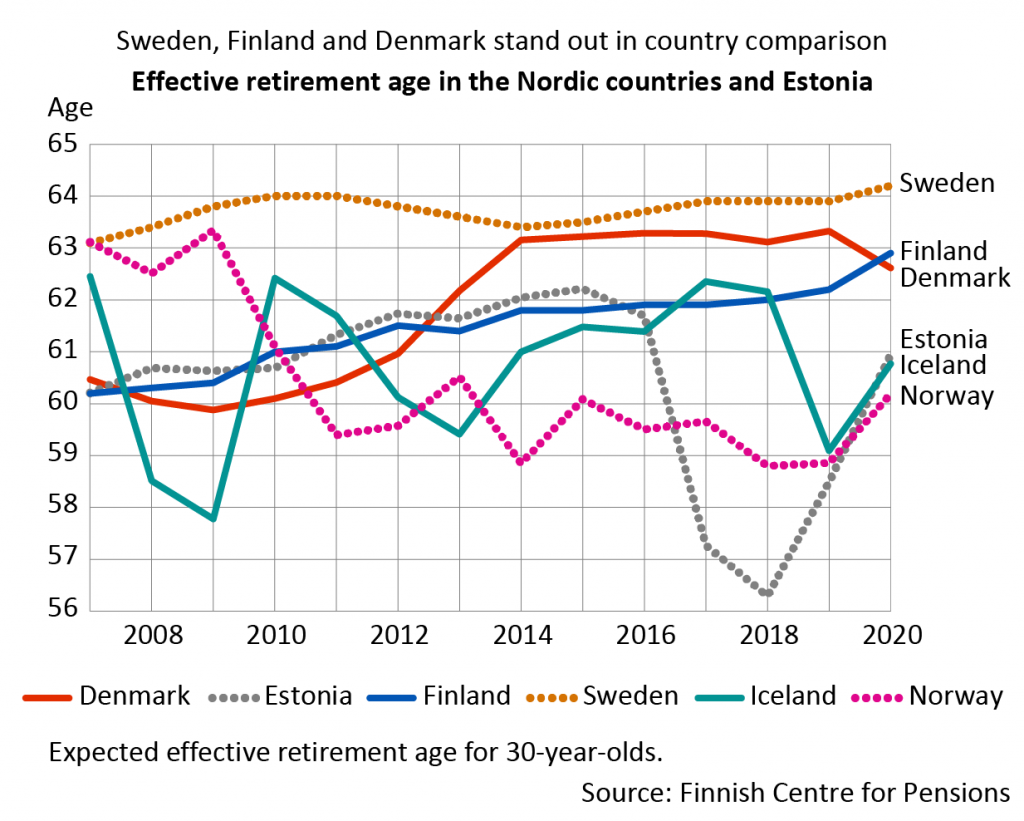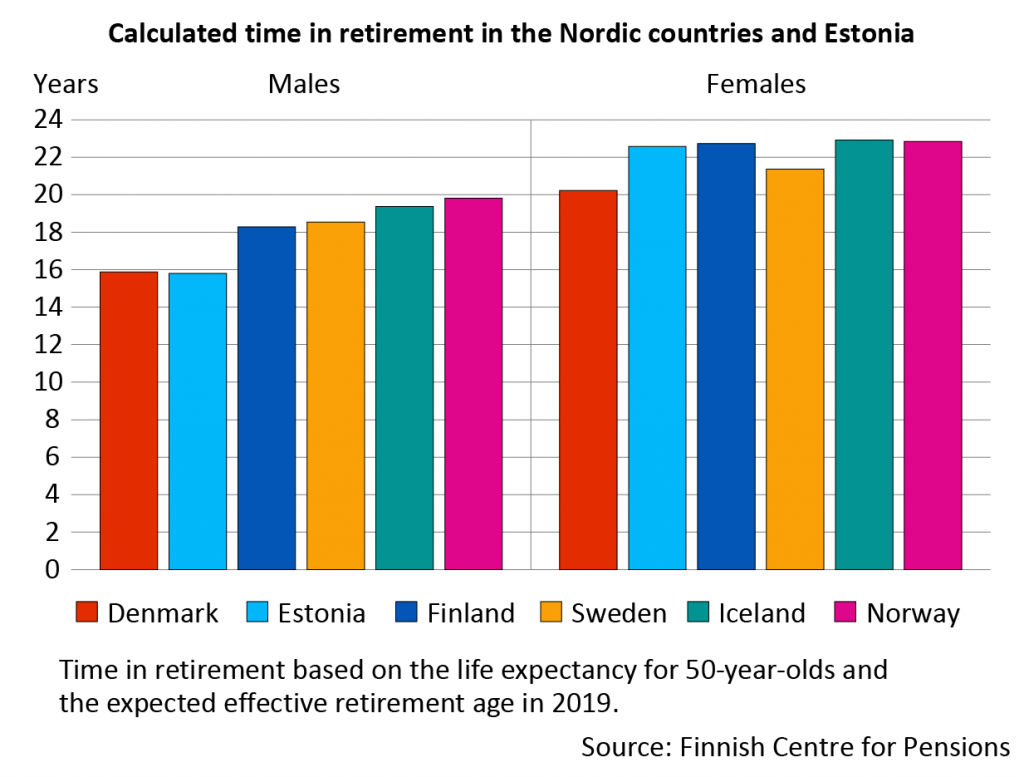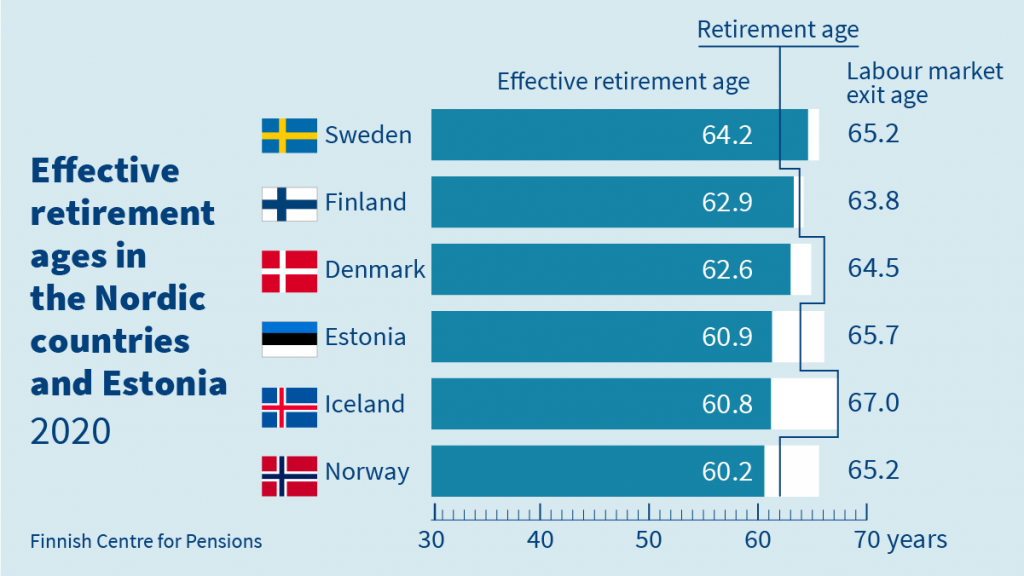Highest effective retirement age in Sweden – Finland among the top three

Sweden, Finland and Denmark stand out with the highest effective retirement ages in a comparison of the Nordic countries and Estonia. Although Finns have postponed retirement markedly in the 2010s, they still exit the labour market at the youngest age. Icelandic, Norwegian and Finnish women spend the longest time in retirement.
The Finnish Centre for Pensions compared the effective retirement ages and the labour market exit ages in the Nordic countries and Estonia in 2007–2020.
All countries compared have underwent pension reforms during the review period. The purpose of the reforms is to extend working lives and secure pension payments as the population ages.
The effective retirement age of the Swedes is the highest of the compared countries throughout the 2010s. On average, Swedes retire at age 64.2 years (in 2020).
Next in line are the Finns and the Danish, who retire about one year younger. Both countries have improved their ranking considerably in the 2010s. Norway comes in last in the comparison. It is possible to take out pension in full already before the general retirement age in Norway.
Pension reforms explains Finland’s improved ranking
The favourable development of Finland is explained by the abolishment of early exit routes and the gradually rising retirement age. In 2007, Finland was at the bottom of the comparison in terms of effective retirement age. Denmark is the only other Nordic country that has managed to improve its ranking in a similar way. In Denmark, the improved ranking is explained by the disability pension reform and an increase in the retirement age.
The situation is essentially different in terms of the labour market exit age. Compared from that point of view, Finland and Denmark are at the bottom since, in both countries, people often stop working as soon as they retire. In the other countries included in the comparison, people commonly work in retirement – for example, part time. “People have retired on early pensions in Finland and Denmark more frequently than in the other Nordic countries. In both countries, the effects of the pension reforms in the 2010s are evident in rising labour market exit ages and effective retirement ages. On the other hand, there is still room for improvement in the former,” says liaison manager Mika Vidlund (Finnish Centre for Pensions).

Finnish women enjoy retirement for a long time
Women’s life expectancy is several years higher than men’s. This also means that they spend more time in retirement.
Icelandic, Norwegian, Finnish and Estonian women spend the longest time in retirement – around 23 years. Danish women spend the least number of years (20 yrs) in retirement.
The Norwegian men spend the longest time in retirement (20 yrs). Estonian and Danish men spend the shortest time in retirement: 16 years on average. In Finland and Sweden, the time spent in retirement is average: an ample 18 years.
The gap between men’s and women’s time spent in retirement is nearly five years even if they retire, on average, at the same age.
“We are going in the right direction but, highly generalising, Finnish men still live fairly unhealthy lives. Although some improvement has occurred, they are unlikely to catch up with the life expectancy of women. That is why Finnish women will get to enjoy more years in retirement than men also in the future,” development manager Jari Kannisto (Finnish Centre for Pensions) assesses.


Central concepts of comparison of Nordic countries Estonia
Effective retirement age
- depicts the average retirement age if the retirement contingencies and the mortality rates remain on the level of the review year;
- is independent of the demographic age structure and calculated following the same principle as when calculating the expected life expectancy that measures the life span;
- is calculated for the 30-year-olds. National pensions are included in the figures for Finland.
Labour market exit age
- depicts the average age of exit from the labour market;
- is calculated based on shares of people in the labour force in the age groups of those aged 50 or older.
Time in retirement
- a computational variable that depicts the average time spent in retirement;
- is calculated as the difference between the expected effective retirement age and the life expectancy (Eurostat) of 50-year-olds.
Read more:

